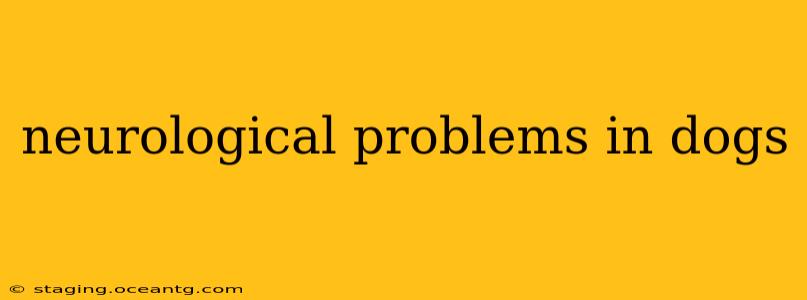Neurological problems in dogs can manifest in various ways, causing significant distress for both the pet and their owner. Understanding the potential causes, symptoms, and treatments is crucial for early diagnosis and effective management. This comprehensive guide explores common neurological issues in canines, providing valuable information for concerned pet owners.
What are the common neurological problems in dogs?
Numerous neurological conditions can affect dogs, ranging from relatively minor to severely debilitating. Some of the most prevalent include:
-
Intervertebral Disc Disease (IVDD): This is a common cause of neurological problems, particularly in breeds prone to it like Dachshunds and Beagles. IVDD involves the degeneration of the discs between the vertebrae in the spine, potentially leading to compression of the spinal cord. Symptoms can range from mild back pain to complete paralysis.
-
Epilepsy: Canine epilepsy is characterized by recurrent seizures. While the exact cause is often unknown, it can be triggered by various factors. Seizures can vary in severity and duration, and proper management is crucial to improve the dog's quality of life.
-
Brain Tumors: Tumors in the brain can cause a wide array of neurological symptoms, depending on their location and size. These can range from subtle behavioral changes to severe neurological deficits.
-
Meningitis and Encephalitis: These infections affect the brain and spinal cord's protective membranes, often caused by bacteria, viruses, or fungi. Symptoms can include fever, lethargy, and neurological dysfunction.
-
Degenerative Myelopathy: This progressive disease affects the spinal cord, causing weakness and paralysis in the hind limbs. It's often seen in older dogs.
-
Stroke: Similar to strokes in humans, canine strokes occur when blood flow to the brain is interrupted. This can result in sudden neurological deficits, such as paralysis or loss of coordination.
What are the symptoms of neurological problems in dogs?
Recognizing the signs of neurological problems is vital for timely veterinary intervention. Symptoms can be subtle or dramatic and vary depending on the underlying cause and location of the problem. Common symptoms include:
- Changes in behavior: Increased aggression, anxiety, confusion, or changes in personality.
- Head pressing: The dog repeatedly pushes its head against walls or objects.
- Seizures: Episodes of uncontrolled shaking, muscle spasms, or loss of consciousness.
- Muscle weakness or paralysis: Difficulty walking, stumbling, or inability to use limbs.
- Loss of coordination (ataxia): Walking with a wide stance, stumbling, or falling.
- Changes in gait: Dragging limbs, circling, or difficulty turning.
- Loss of bladder or bowel control: Incontinence or difficulty urinating or defecating.
- Blindness or deafness: Loss of vision or hearing.
- Vocalization changes: Excessive barking, whining, or unusual vocalizations.
- Head tilt: An abnormal tilting of the head.
How are neurological problems in dogs diagnosed?
Diagnosing neurological problems often involves a combination of:
- Thorough physical examination: The veterinarian will carefully assess the dog's neurological function.
- Neurological exam: This involves specific tests to evaluate reflexes, muscle strength, and coordination.
- Blood tests: To rule out other medical conditions and assess overall health.
- Imaging tests: X-rays, MRI, and CT scans can help visualize the brain and spinal cord to identify tumors, injuries, or other abnormalities.
- Cerebrospinal fluid (CSF) analysis: This involves taking a sample of fluid from the spinal cord to identify infections or other abnormalities.
- Electromyography (EMG) and nerve conduction studies: These tests help evaluate the function of muscles and nerves.
What is the treatment for neurological problems in dogs?
Treatment for neurological problems varies greatly depending on the underlying cause. Options may include:
- Medication: To manage seizures, pain, inflammation, or infections.
- Surgery: To remove tumors, repair spinal cord injuries, or address other structural problems.
- Physical therapy and rehabilitation: To improve muscle strength, coordination, and mobility.
- Supportive care: To manage symptoms and improve the dog's quality of life.
What are the long-term effects of neurological problems in dogs?
The long-term effects of neurological problems depend on the specific condition, its severity, and the effectiveness of treatment. Some dogs may make a full recovery, while others may experience permanent disabilities. Supportive care and rehabilitation are crucial for maximizing the dog's quality of life.
How can I prevent neurological problems in my dog?
While not all neurological problems are preventable, some measures can reduce the risk:
- Maintain a healthy weight: Obesity can increase the risk of IVDD.
- Provide regular exercise: But avoid strenuous activities, especially for breeds prone to IVDD.
- Feed a high-quality diet: Proper nutrition supports overall health.
- Regular veterinary checkups: Early detection can improve treatment outcomes.
This information is for general knowledge and should not replace professional veterinary advice. If you suspect your dog is experiencing neurological problems, consult your veterinarian immediately for proper diagnosis and treatment. Early intervention is crucial for the best possible outcome.
